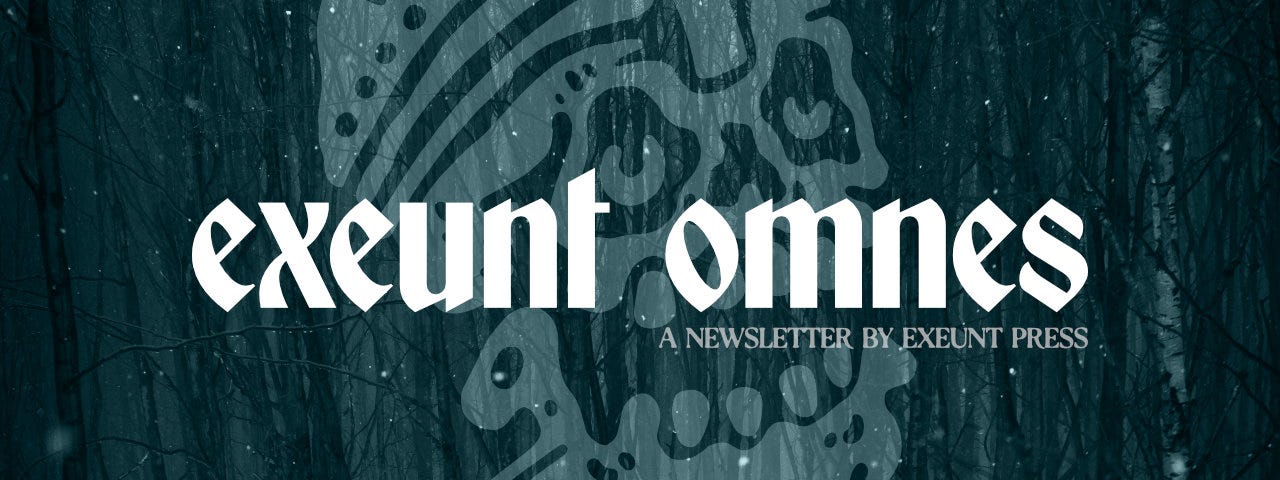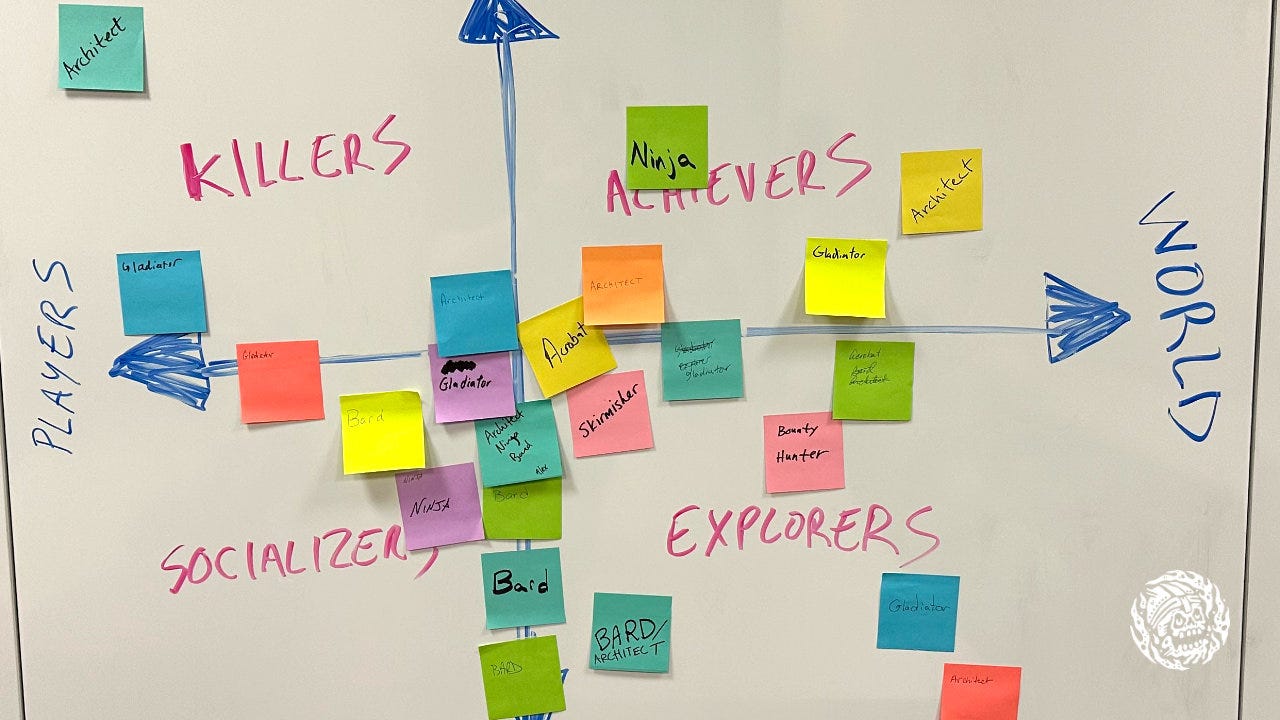What makes a hexcrawl great?
Rolling for theme, forcing the game to end, hexcrawls, and Modern Art
Welcome to Exeunt Omnes, the official newsletter for loyal fans and sworn enemies of Exeunt Press, creator of games such as Exclusion Zone Botanist and Eleventh Beast. You can find digital games at games.exeunt.press and physical products at shop.exeunt.press.
TL;DR Summary
🦖 Roll for theme!
⏰ Forcing the game to end
🗺️ What makes a hexcrawl great?
🎲 Recently played: Modern Art: The Card Game
🦖 Roll for theme!
I mentioned last time that I’m teaching a tabletop game design class at a public library. We’ve now had two of the four sessions, and it’s been an absolute joy!
The room has been packed with about 25 highly engaged and creative people each week. It’s a wonderful mix of board gamers, TTRPG players, writers, artists, and everything in between.
The first week was all about different types of players and different types of games. We did a little exercise where everyone wrote their Quantic player type on a Post-It note, and then everyone put them on the Bartle Taxonomy quadrants. It was interesting to see how the two different player models matched up!
Last week focused on theme vs. mechanism and why both are important. The exercise used a random d6+d12 table to help generate themes:
We then created short pitches for re-themed classic games (e.g. Candy Land, Battleship, etc.) with a new mechanism added. The pitches were fantastic! We had jungle Vikings, zombies hunting for old vinyl records, historical spies, artist battles, and more.
This week we’ll focus on crafting player experiences, agency, and providing players with interesting choices. I can’t wait!
READ: 10 tips for teaching a tabletop game class at Exeunt Omnes
⏰ Forcing the game to end
At Skeleton Code Machine, we recently looked at Knarr and how its Reputation track helps force the game to end.
This same general idea (i.e. the game has time pressure applied outside of the player’s direct control) has important applications in TTRPGs. Adding some time pressure can really make actions feel important, and force players to make tough decisions.
Read the whole article for some ideas on how to add this to your next game design.
READ: The Final Countdown at Skeleton Code Machine
Skeleton Code Machine is a weekly publication that explores tabletop game mechanisms in board games and roleplaying games. It’s been called a “Seemingly endless source of gaming ponderings” and a “Goldmine.” Check it out at www.skeletoncodemachine.com.
🗺️ What makes a hexcrawl great?
There was a recent thread on Reddit asking about what makes one hexcrawl better than another. How do we make hexcrawls that are fun?
It’s a great question, similar to the What makes a MÖRK BORG module good? question from last year. Many of the concepts apply regardless if it’s a classic TTRPG campaign hexcrawl, an adventure game like MIRU, or an exploration board game.
Here are 13 tips from the thread (and other things I’ve found) that might be helpful:
Have a clear purpose: Hex maps are great for exploration and wandering around. While the idea of an open world sandbox might sound fun, give the players an objective. They’ll still end up exploring and side-questing their way around the map, but will have a reason to do so: find the castle, loot the cave, or deliver the goods.
Create modular hex maps: Consider making the map modular, so finding one hex unlocks a large new area of hexes. Rather than just going hex by hex, individual hexes might trigger a larger map change or expansion. This is often used in open world video games, where you reveal the next area of the map.
Generate conflicting factions: Just as you would having multiple factions competing in a very large dungeon area, you could do the same for a hexcrawl. This allows players to bump into factions and attempt to change the balance of power between them.
Provide multiple paths: If players have no information to help choose their direction of travel, it’s basically just random. You can add some interesting player decisions by hinting at multiple paths to an important destination. Do you take the easier but longer path, or the shorter and more dangerous path?
Add some time pressure: The Skeleton Code Machine article on forcing the end of the game applies to hexcrawls as well. If you can take as long as you want to explore, there’s no reason to move forward. By adding a ticking clock to the game, players must choose to explore or keep pressing forward. That clock could be actual time, but also resources. It will make those dangerous shortcuts more attractive!
Add intermediate goals: Particularly for players who want immersion and creativity, provide one central problem that spans multiple zones. Interesting locations and plot hooks should have some connection to the ultimate goal. This can help provide a sense of progression and accomplishment.
Use dungeon design principles: In a dungeon you might have multiple rooms, most containing plot hooks or interesting things to see and do. There is usually, however, a unifying theme and clear connections between each place in the dungeon. That concept of hooks and connections could be applied to hexcrawls as well.
Create distinct regions and environments: It’s hard to do when using procedurally generated hex maps, but breaking the map into zones can make it feel more alive. Examples could be a line of mountains that has some unusual form of life, or a river that divides two kingdoms. A hex flower game engine might help. You can also use Voronoi patterns!
Add landmarks: In the real world, large landmarks (e.g. mountains, towers, etc.) have always been important to navigation. Consider dropping some of these across your map and allowing NPCs to reference them. Make them big enough that they can be seen on the horizon.
Consider a pointcrawl instead: This is sort of cheating (because it’s not a hexcrawl), but it’s worth mentioning. Skip the boring bits and just give your players some interesting travel destinations. You could map out the distances ahead of time, and focus your efforts on building stuff at each landmark or location.
Make a pretty map: Adding some thematic art and a beautiful map can really add to the experience. If you are going to use a player-facing map, check out some tips and resources for using Hex Kit at Skeleton Code Machine.
Make connections to find: Create a network of people and places that are related in some way, and let your players discover them. A knight that lost an arm to a dragon can point to a landmark on the horizon. Conversely, perhaps the dragon is found first. Then the arm in the dragon’s den bears clues pointing to the nearby castle.
Don’t skimp on random encounters: On a large map your players might be rolling for events quite a bit. If your random encounter table is too small, you’ll get repeats and it will quickly become boring. Gauge the random encounter table size based on how many hexes will be travelled.
As a side note, I keep seeing Forbidden Lands mentioned when it comes to open world travel and hex-based mechanics. Haven’t played it yet myself, but I’d love to hear your thoughts on it in the comments!
🎲 Recently played: Modern Art: The Card Game
Reiner Knizia is a master of making mechanically simple games with tough and interesting player decisions. Modern Art (Knizia, 1992) is one of my favorites of his 700 published games. So I was excited to try Modern Art: The Card Game (Knizia, 2008), as it was marketed as a faster, simpler version of the original.
We played with just two players (BGG recommends 4-5), and it was really enjoyable! While I miss the auctions and bidding of the original, the card game distills the tough decisions into a streamlined 20-minute game.
PLAY: Modern Art: The Card Game
Thanks for subscribing to Exeunt Omnes!
Check out games.exeunt.press for all the latest games and resources!
- E.P. 💀








Dude, your posts are always treasure troves of treasure troves of treasure troves. Truly, you have your art down. Inspiring. Thank you a million times over for everything you share.
Also, FIRST!
Loved the part for the hexcrawl. Very useful data! Will use those things in my games!